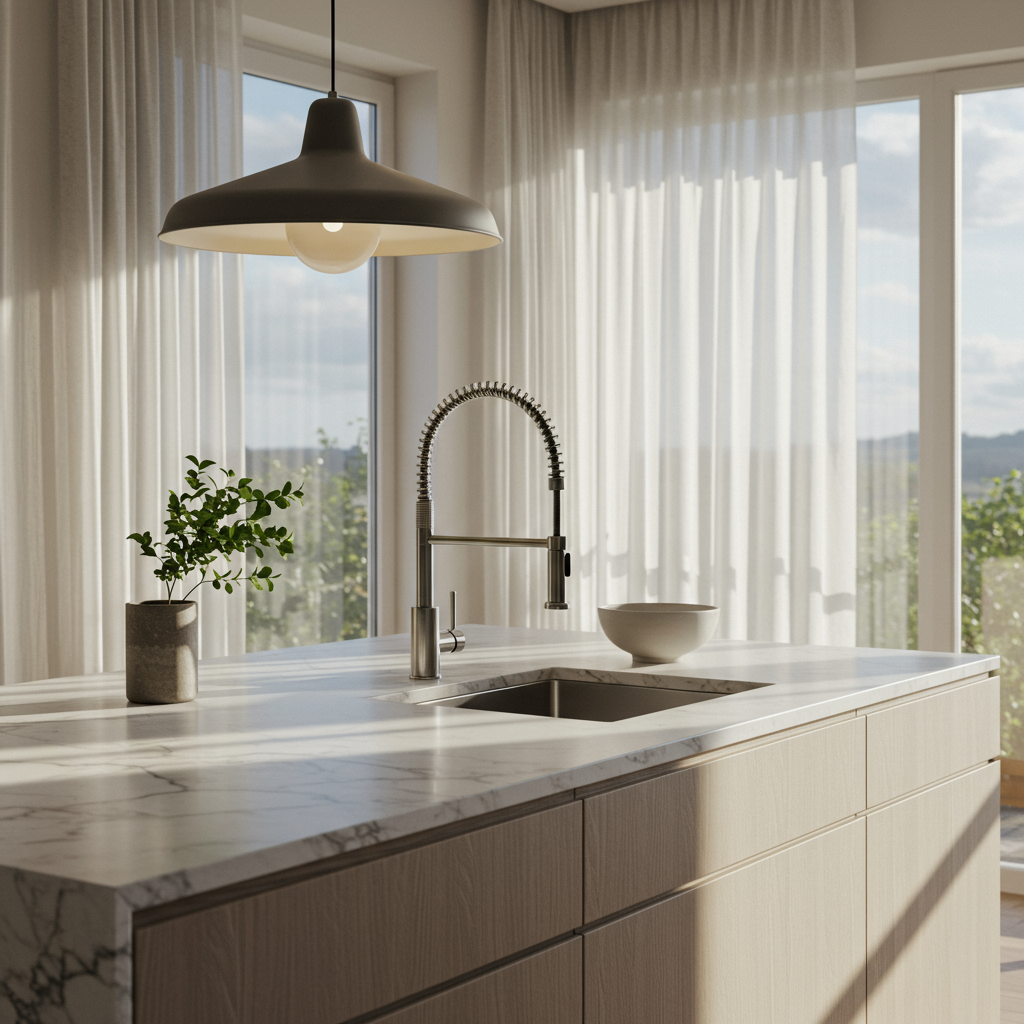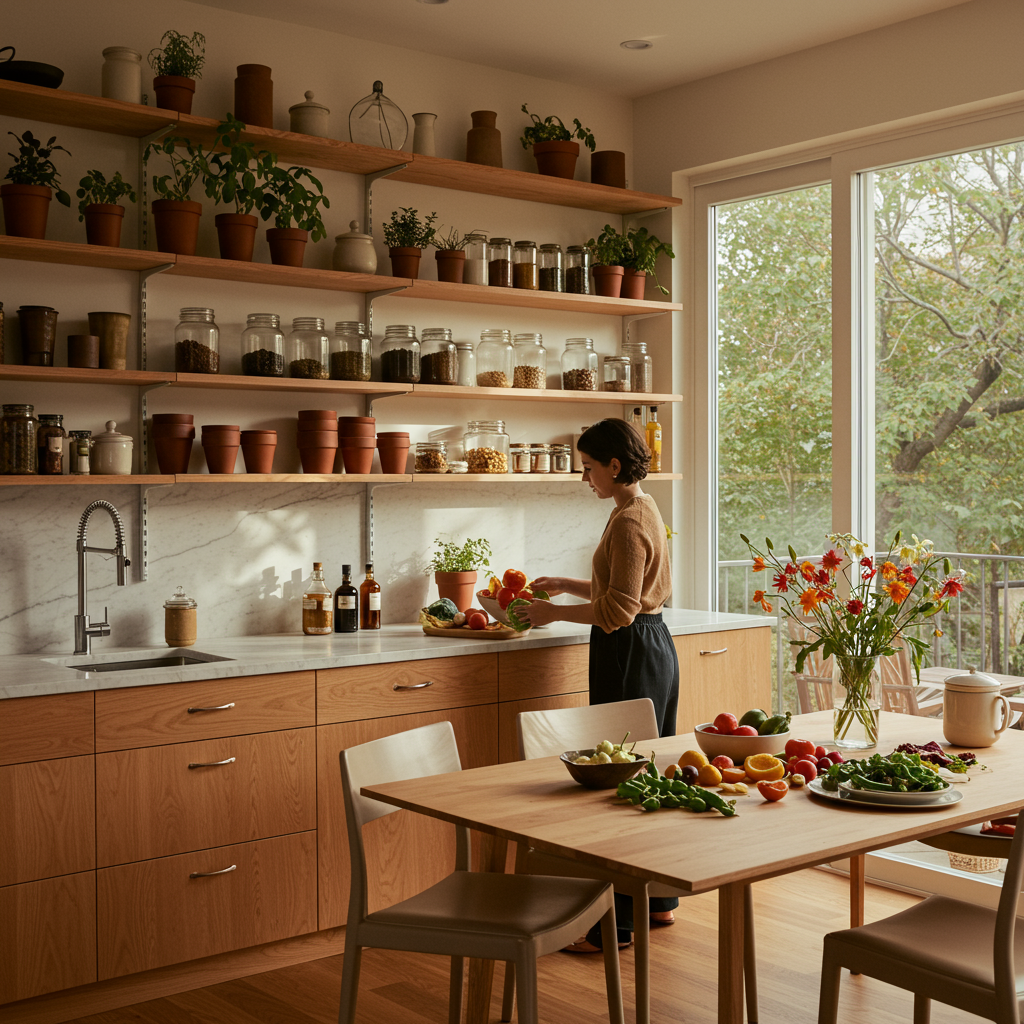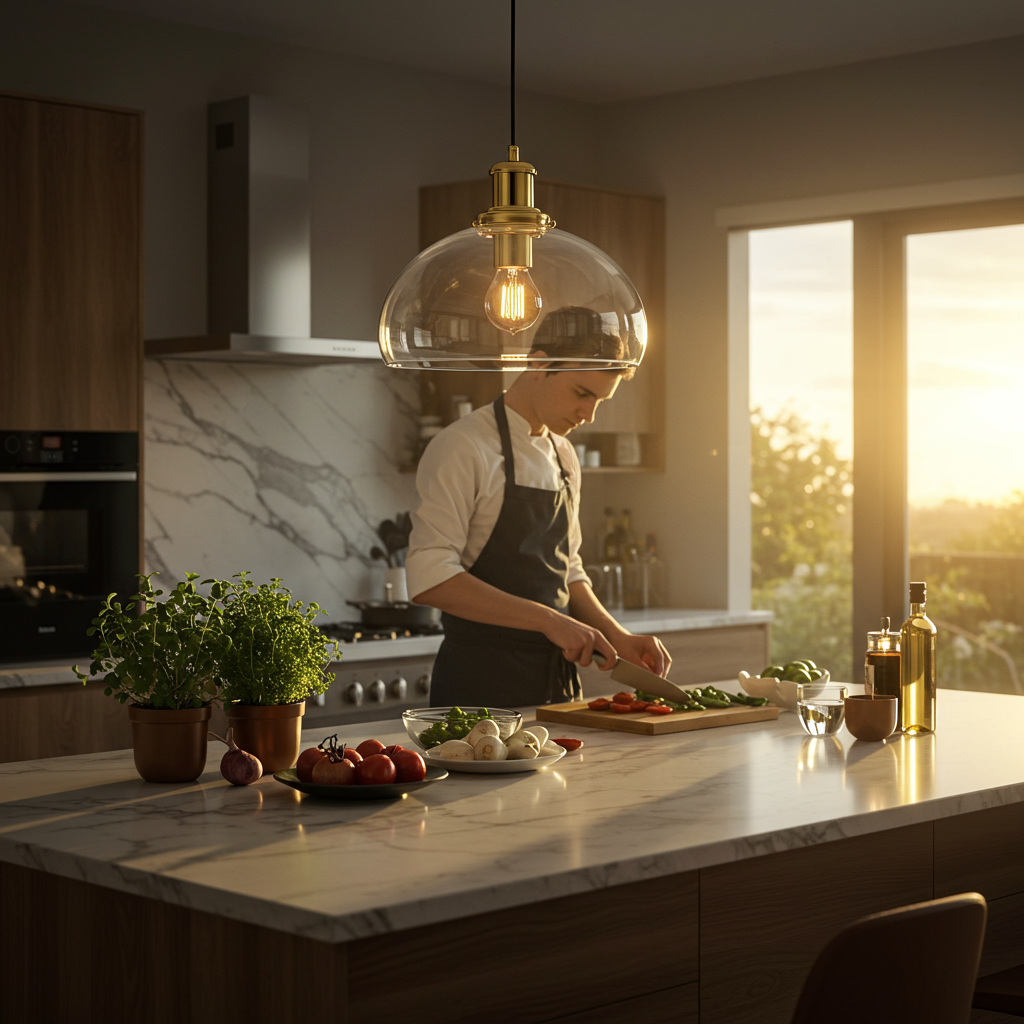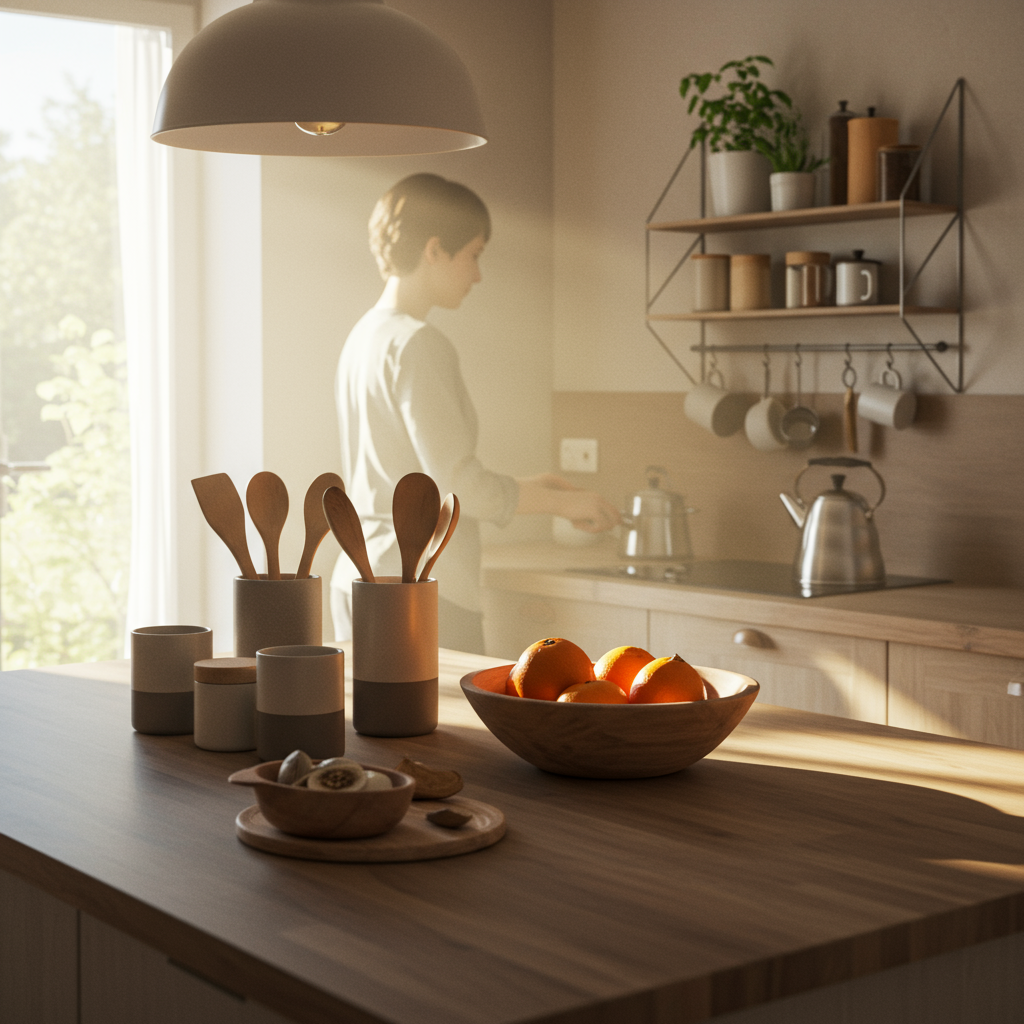In the world of interior design, minimalism has emerged as a dominant trend, especially when it comes to kitchens. A minimalist kitchen not only reflects a clean aesthetic but also promotes functionality and efficiency. With the hustle and bustle of modern life, many homeowners are looking to simplify their spaces, and the kitchen is no exception. If you’re considering a refresh or a complete overhaul of your kitchen, embracing minimalist trends could be just what you need. In this article, we’ll delve into five minimalist kitchen trends that you need to try to create a harmonious, stylish, and practical space.
“`html
| Feature | Details |
|---|---|
| Neutral Color Palette | Use of whites, grays, and earth tones to create a calming environment. |
| Open Shelving | Replacing upper cabinets with open shelves for a more airy feel. |
| Streamlined Appliances | Integration of built-in appliances for a seamless look. |
| Natural Materials | Incorporation of wood, stone, and metal for a rustic yet modern vibe. |
| Minimalist Lighting | Simple, functional light fixtures that enhance the space without clutter. |
| Functional Decor | Use of decor items that serve a purpose, such as stylish storage solutions. |
| Smart Storage Solutions | Innovative storage options to keep countertops clear and organized. |
“`
1. Clean Lines and Simple Shapes

One of the fundamental principles of minimalism is the use of clean lines and simple shapes. This approach encourages the removal of unnecessary ornamentation, which can make a space feel cluttered and chaotic. In a minimalist kitchen, you’ll want to focus on cabinetry and appliances that feature sleek, streamlined designs. Opt for flat-panel cabinet doors that lack detailed moldings or intricate hardware. Instead, consider integrated handles or push-to-open mechanisms for a seamless look.
Additionally, countertops made from materials like quartz or granite can enhance this trend. These surfaces often come in solid colors or subtle patterns, promoting a calm atmosphere. Pairing these clean lines with a neutral color palette, such as whites, grays, or soft earth tones, will further solidify the minimalist aesthetic.
2. Open Shelving

Another trend gaining popularity in minimalist kitchens is open shelving. Unlike traditional cabinets that hide away your kitchen items, open shelving encourages you to display your dishware, glassware, and even cookbooks. This not only creates a visually appealing focal point but also promotes an organized space where everything is easily accessible.
To make the most of open shelving, consider these tips:
- Limit Your Display: Only showcase items that you use regularly or that have personal significance. This ensures that your shelves remain uncluttered.
- Mix and Match: Combine different materials and textures, like wood and metal, to add visual interest while maintaining a cohesive look.
- Be Strategic: Place frequently used items at eye level while storing less common items higher up.
Open shelving can also encourage creativity in styling. Use decorative baskets or trays to corral smaller items, and consider adding a few plants or artwork to enhance the aesthetic appeal.
3. Integrated Appliances
In a minimalist kitchen, less is often more, and this is especially true when it comes to appliances. Integrated appliances are designed to be built into cabinetry, allowing for a streamlined and cohesive appearance. This trend helps to eliminate visual clutter, making your kitchen feel more expansive and organized.
When selecting integrated appliances, look for options that blend seamlessly with your cabinets. For example, a refrigerator can be camouflaged with cabinetry panels, while dishwashers can feature matching fronts. This integration allows for a uniform look that emphasizes the clean lines typical of minimalist design.
In addition to aesthetics, integrated appliances often boast advanced technology and energy efficiency, making them a practical choice for modern kitchens. As you consider your appliance options, think about how each item will contribute to the overall design and functionality of your space.
4. Minimalist Color Schemes
Color plays a significant role in minimalist design. A well-thought-out color scheme can evoke feelings of calm and simplicity, two essential components of minimalism. For a minimalist kitchen, consider using a limited palette of neutral colors, such as whites, grays, and beiges, that can create a serene backdrop.
You can also incorporate a single accent color to add depth and interest without overwhelming the space. This could be a soft pastel or a bold hue, depending on your personal style. The key is to maintain balance; choose a few colors and stick to them throughout the kitchen for a cohesive look.
Additionally, consider the finish of your colors. Matte finishes tend to promote a more understated and modern aesthetic compared to glossy finishes, which can be more visually distracting. Overall, a carefully chosen color scheme can enhance the minimalist vibe of your kitchen.
5. Smart Storage Solutions
Finally, effective storage solutions are essential in a minimalist kitchen. Clutter can quickly undermine the clean aesthetic you’re aiming for, so it’s crucial to maximize your storage options. Look for innovative storage solutions that can help you keep your kitchen organized while maintaining the minimalist ethos.
Consider incorporating pull-out drawers, hidden compartments, or sliding shelves that utilize every inch of available space. Additionally, magnetic strips can help keep knives organized and within reach, while drawer dividers can keep utensils neatly sorted.
By employing smart storage solutions, you can ensure that your minimalist kitchen remains functional and uncluttered, allowing you to enjoy the beauty of simplicity.
6. Natural Materials

Incorporating natural materials into your minimalist kitchen design can create a warm and inviting atmosphere without compromising the sleek aesthetic. Materials such as wood, stone, and bamboo not only add texture but also promote a connection to the natural environment, which aligns perfectly with minimalist principles. Opt for wooden countertops, stone backsplashes, or bamboo shelving to infuse authenticity and warmth into your space.
When selecting natural materials, consider their sustainability and how they fit into your overall design scheme. For instance, reclaimed wood can add character and history, while quartzite or granite can provide a luxurious touch with their unique patterns. By mixing and matching these materials, you can create a layered look that remains cohesive and uncluttered.
Additionally, the finishing touches matter. A matte finish on wooden surfaces can enhance the natural grain, while polished stone can add a refined elegance. Not only do natural materials enhance the visual appeal of your minimalist kitchen, but they also bring durability and practicality, making them ideal for high-traffic spaces.
7. Statement Lighting

Lighting is a key element in any kitchen design, and in a minimalist space, it serves both functional and aesthetic purposes. Statement lighting fixtures can become the focal point of the room while still adhering to minimalist principles. Look for pendant lights, sculptural chandeliers, or sleek track lighting that adds character without overwhelming the design.
When selecting light fixtures, consider their shape and material. Opt for designs with clean lines and geometric forms that complement your kitchen’s overall aesthetic. A striking pendant light made from metal or glass can provide a modern touch, while a wooden fixture can enhance the natural vibe of your space.
Additionally, layering your lighting can create depth and ambiance. Combine ambient lighting with task lighting—such as under-cabinet lights or recessed lighting—to ensure functionality while maintaining a minimalist feel. Dimmers can also provide flexibility, allowing you to adjust the mood of your kitchen based on the time of day or occasion.
8. Functional Decor

In a minimalist kitchen, less is more, but that doesn’t mean you have to forgo decor entirely. The key is to choose decor that serves a purpose while enhancing the design. Functional decor items can include stylish kitchen tools, attractive storage containers, or aesthetically pleasing utensils. These items not only serve their intended function but also contribute to the overall ambiance of the kitchen.
For example, consider investing in high-quality cutting boards made from beautiful hardwood, or opt for ceramic storage jars that can double as decorative accents. Displaying your most-used kitchen tools, like a set of designer knives or a unique spice rack, can add personal flair without cluttering the space.
Additionally, don’t hesitate to incorporate artwork or wall hangings that resonate with your style. A large, framed print or a collection of small, minimalist pieces can create visual interest without overwhelming your kitchen’s streamlined look. Just remember to keep it simple—select a few pieces that speak to you, and allow them to shine in your minimalist design.
9. Sustainable Practices
Minimalism is inherently linked to sustainability, making eco-friendly practices a natural fit for your kitchen remodel. As you design your minimalist kitchen, consider incorporating sustainable materials and practices that reduce waste and environmental impact. This can include low-VOC paints, energy-efficient appliances, and sustainably sourced materials.
Moreover, think about how you can minimize food waste in your kitchen. Implementing a composting system or using reusable storage solutions can contribute to a more sustainable lifestyle. Your minimalist kitchen can serve as a model for simplicity and efficiency, encouraging you to make conscientious choices that benefit both your home and the planet.
10. Flexibility in Design
Flexibility is an essential element in the minimalist kitchen, especially as lifestyles and needs evolve over time. Consider designing spaces that can adapt to various functions, such as a kitchen island that doubles as a dining area or a workspace for homework or crafts. Incorporating movable furniture or elements that can be easily reconfigured allows for a more versatile and functional space.
Additionally, choosing modular storage solutions can provide the flexibility needed as your storage requirements change. Adjustable shelving or stackable storage bins can be tailored to fit your current needs while maintaining a clean and uncluttered look. By designing your kitchen with flexibility in mind, you can ensure that it remains practical and enjoyable for years to come.
11. Textured Surfaces
While minimalism often emphasizes simplicity, incorporating textured surfaces can add depth and visual interest to your kitchen without overwhelming its clean lines. Textured elements can create a tactile experience and enhance the overall aesthetic of your space. Think about using materials with varying textures, such as a rough-hewn wooden countertop paired with smooth ceramic tiles or a matte-finish cabinetry alongside polished stone elements.
When selecting textures, aim for a balance that complements the minimalist philosophy. For instance, a textured backsplash made from handmade tiles can serve as a stunning focal point while still keeping the overall look uncluttered. Similarly, woven baskets can add warmth and organization without taking away from the minimalist design. Just be sure to maintain a cohesive color scheme across different textures to avoid visual chaos.
12. Outdoor Connectivity
Incorporating elements that connect your kitchen to the outdoors is another emerging trend in minimalist design. This approach fosters a sense of openness and brings in natural light, enhancing the airy feel that minimalism strives for. Consider installing large windows or sliding glass doors that open up to a patio or garden space. This seamless transition between indoor and outdoor areas can make your kitchen feel more expansive and inviting.
In addition to enhancing natural light, outdoor connectivity can also inspire the use of natural materials in your kitchen design. Consider extending your countertop space or dining area outdoors, creating a harmonious flow between the two environments. Utilizing outdoor-friendly materials, such as weather-resistant woods or stone, ensures that your kitchen remains stylish and functional, both inside and out.
13. Monochrome Color Schemes
While a limited palette is essential in minimalist kitchens, embracing a monochrome color scheme can take this concept a step further. A monochrome approach focuses on varying shades and tones of a single color, creating a sophisticated and cohesive look. This technique allows you to experiment with different textures and materials while maintaining a streamlined aesthetic.
For example, using various shades of gray can create a serene and sophisticated kitchen environment. Pair light gray cabinetry with darker countertops and stainless steel appliances for a polished look. You can also introduce subtle variations in texture, such as matte finishes on cabinetry and gloss on tiles, to add depth without introducing additional colors. A monochrome palette can elevate the minimalist design, emphasizing simplicity while still feeling rich and inviting.
14. Technology Integration
As technology continues to evolve, integrating smart home features into your minimalist kitchen can enhance both its functionality and efficiency. From smart appliances to automated lighting systems, the integration of technology aligns perfectly with the minimalist ethos of simplicity and ease of use. A well-designed smart kitchen can streamline your cooking and cleaning processes, allowing you to focus on enjoying your space.
Consider incorporating touchless faucets, smart refrigerators that allow you to manage inventory, or ovens that can be controlled remotely. These features not only reduce clutter but also add a level of convenience that complements the minimalist lifestyle. Additionally, smart lighting solutions can adjust based on the time of day or mood, providing the perfect ambiance without the need for excessive fixtures.
15. Personal Touches
While minimalism emphasizes simplicity, it’s essential to incorporate personal touches that reflect your style and personality. A minimalist kitchen can be warm and inviting, even with a restrained aesthetic. Select a few beloved items that resonate with you—be it a cherished cookbook, a vintage utensil set, or artwork that inspires you. These elements can serve as conversation starters and bring life to your space without cluttering it.
To enhance this personalization, consider creating a dedicated space for displaying these cherished items. A small shelf above the countertop or a designated wall can serve as an ideal spot for these personal touches, providing a visual focal point that remains organized. Remember, the goal is to choose items that resonate with you while adhering to the overall minimalist design, ensuring that each piece adds value to your kitchen.
16. Layered Lighting Options
Lighting is a critical element in creating a minimalist kitchen ambiance. Layering your lighting options can provide flexibility and enhance the functionality of your space. Aim for a combination of ambient, task, and accent lighting to ensure your kitchen is well-lit for cooking, entertaining, and relaxing. Ambient lighting can be achieved through overhead fixtures, while task lighting is essential for work areas like countertops and islands.
Accent lighting can highlight specific features in your kitchen, such as artwork or architectural details. Consider installing under-cabinet lighting to illuminate work surfaces, or add pendant lights over the island to create a cozy atmosphere. Dimmable fixtures provide the flexibility to adjust the mood based on the time of day or occasion, ensuring your kitchen remains an inviting hub for family and friends.
17. Minimalist Hardware Choices
When it comes to hardware, opting for minimalist designs can significantly impact the overall look of your kitchen. Choose sleek, streamlined hardware that aligns with the clean lines characteristic of minimalist design. Avoid ornate or overly detailed hardware that can detract from the simplicity of your space.
Consider options such as flat bar pulls or integrated handles that blend seamlessly into cabinetry. If you prefer a touch of contrast, matte black or brushed nickel finishes can provide a modern touch without overwhelming the design. Remember, even the smallest details, like your hardware choices, contribute to the overall minimalist aesthetic, so choose wisely.
As you explore these additional trends, keep in mind that the essence of minimalism lies in creating a space that reflects your values, needs, and lifestyle. Each choice should contribute to a harmonious and functional environment that allows you to enjoy the beauty of simplicity in your kitchen.
